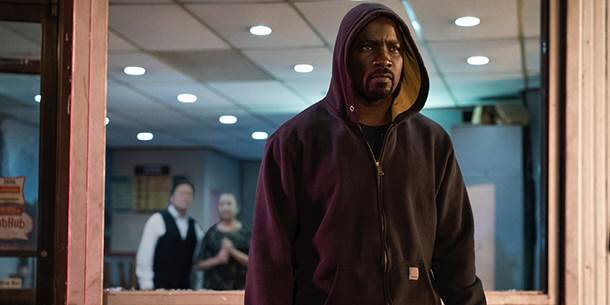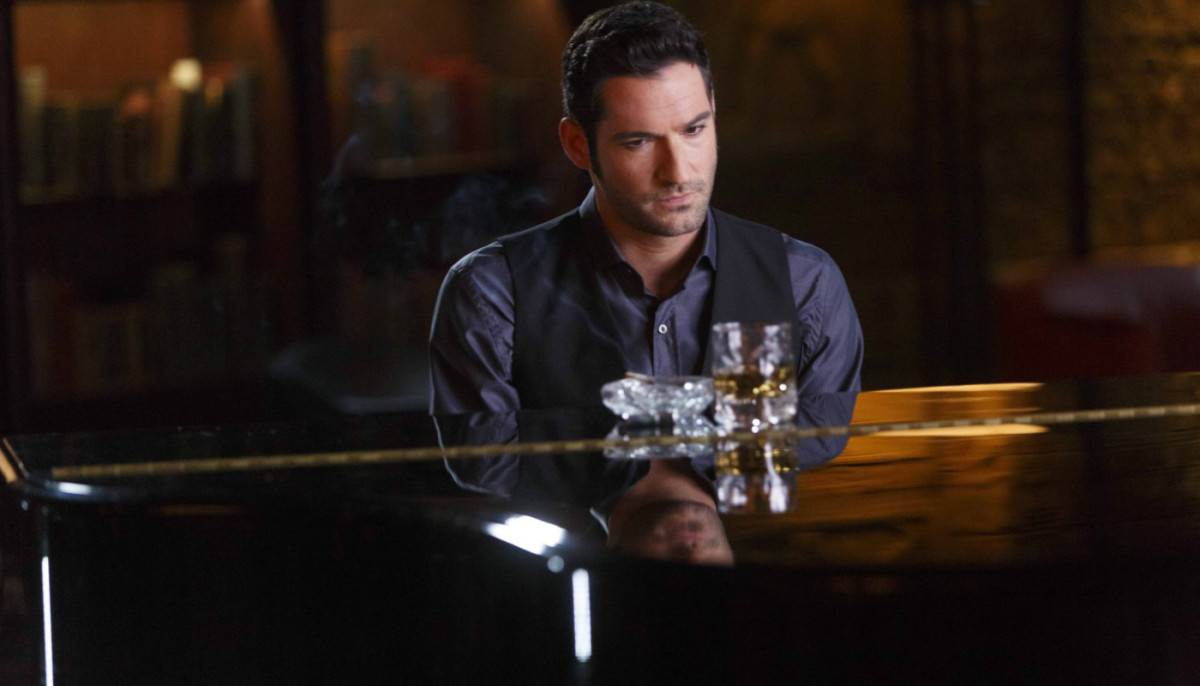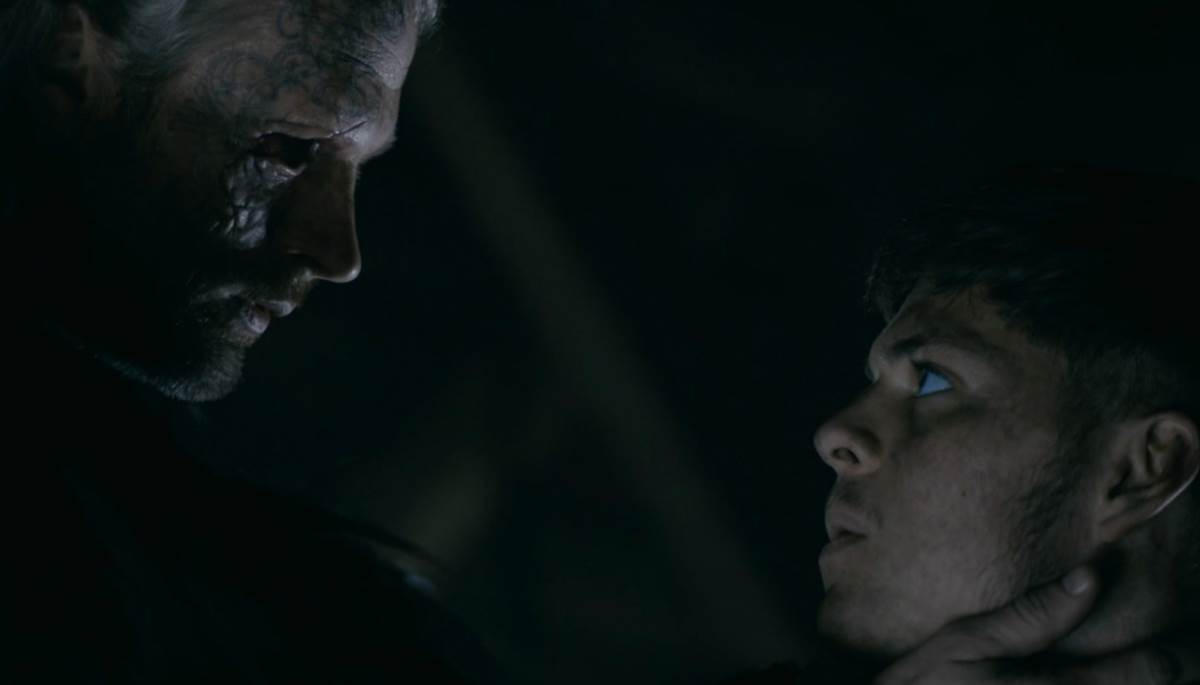Movies News
Marvel Studios Countdown: Rating Every Episode of 'Luke Cage'

Some of you have been waiting since 2015’s Jessica Jones for more of Mike Colter as Luke Cage, but there are many fans who’ve waited since 1972 to see “Power Man” brought to life. Anticipation is sky high for the Netflix exclusive series Luke Cage, which brings back Colter in a cast with Simone Missick, Alfre Woodard, Mahershala Ali, and Erik LaRay Harvey as Marvel Comics’ Misty Knight, Mariah Dillard, Cornell Cottonmouth, and Diamondback, respectively.
There are several references to the events of Daredevil and Jessica Jones, so it’s suggested (but not at all required) that you watch those series first. The Marvel movie connections are more tenuous, with some mentions of the Avengers and aliens, but little else.
Did Luke Cage deliver?
Spoilers below….
Episode 1: Moment of Truth
We catch up with Luke Cage while he struggles to pay rent by sweeping hair at Pop’s Barbershop and doing under the table work at the Harlem’s Paradise nightclub. He’s trying to remain inconspicuous, despite being goaded by Pop to be more heroic (this is a conversation that happens between various people and Luke Cage throughout the series).
Harlem’s Paradise is controlled by “Cottonmouth” Cornell Stokes, who has a complicated relationship with his unscrupulous cousin Councilwoman Mariah Dillard. We meet underworld jack of all trades Shades and get our first mention of a man-behind-the-curtain named “Diamondback” (though the character’s reveal is still several episodes away). Luke Cage takes a shift at Harlem’s Paradise from an absent bartender (who’s actually out stealing money and weapons from Cottonmouth) and beds Misty Knight, a cop who’s working undercover at the bar, all in the same night.
Our first display of “Power Man’s” power is a good one. He takes a slow-motion punch to the face that destroys the wrist of his attacker, then foils an extortion ring shaking down the Chinese restaurant that sits below his apartment.
Unlike the first episodes of Daredevil or Jessica Jones, there’s not a whole lot of focus on the title character. Instead, the Harlem setting and secondary characters are given precedence over Cage (which ends up being emblematic of the approach of the entire series).
Four out of five Power Man heads.

Episode 2: Code of the Streets
The first big conflict of the show concerns the theft of Cottonmouth’s weapons and money. The thieves include one of the lifelong regulars at Pop’s, a kid named Chico. One of the best character moments of the series is in this early episode, as Cottonmouth comes in for a shave at Pop’s and things get delightfully tense between him and Cage. Pops is able to talk some sense into Chico and send Cage to arrange a parley with Cottonmouth. Turk (the neighborhood stool pigeon as seen on Daredevil) rats out Chico to Cottonmouth’s goons.
Taking the (wrong-headed) initiative, the thugs gun down the barbershop, killing Pops, injuring but not killing Chico, and working an unscathed Luke Cage into an emotional rage.
Five out of five Power Man heads.

Episode 3: Who’s Gonna Take the Weight
Cage retaliates to the shooting by attacking Cottonmouth’s financial safehouses, including Mariah’s headquarters at the Crispus Attucks Building. Three episodes in and the show has been fairly light on action and heavy on talking, so Cage’s attacks (set to Charles Bradley’s rocking “Ain’t It a Sin” and Wu Tang’s “Bring da Ruckus”) are like food to the hungry. Misty’s partner Scarfe reveals his own scumbaggery by killing Chico and passing Luke Cage’s address off to Cottonmouth, who blows up Cage’s place with a rocket launcher.
Four out of five Power Man heads.

Episode 4: Step Into the Arena
While Cage struggles to free himself and his landlord from the rubble of his destroyed apartment building, we flashback to Cage’s origin story. It’s about as faithful a retelling as comic book readers could ask for. Cage is an innocent man behind bars at Seagate, manipulated into prison fights that eventually land him in an experimental treatment program. That treatment gives him super-strength and unbreakable skin, and he use the powers to break out of prison. All of this (including an exciting visual nod to the original Power Man costume) is intercut with Cage’s struggle with the rubble, which recalls the classic scene from Amazing Spider-Man #33 where Spider-Man does the same. If the episode has a downside in retrospect, it’s that we’re never told what the experiments are for in the first place.
“Step Into the Arena” is the peak of the series. Mike Colter gets the spotlight to himself, giving us a fully realized vision of who Luke Cage is at last. Parisa Fitz-Henley makes a strong impression as psychologist Reva Connors, a character whose name resonates throughout the series. This is the last time, for a long time, that we’ll see the show embrace its fun comic book roots in favor of criminal politicking.
Five out of five Power Man heads.

Episode 5: Just to Get a Rep
After emerging from the rubble, Cage finds himself outed as a local hero. Cottonmouth is reeling from his losses and decides that neighborhood businesses should pay a “Luke Cage tax.” His thugs start taking what they can from Harlem neighbors and telling them to blame Cage for their sudden misfortune. Cage isn’t having any of that, though, and goes about throttling Cottonmouth’s goons to return most of the “tax” they procured. Cottonmouth and Cage try to one-up each other with inspiring speeches about Harlem at Pop’s funeral service.
Twice in this episode, Misty Knight pleads with Cage to stop being a hero and get out of town, but Cage refuses (this will create a strange narrative problem in the next episode). Daredevil’s nurse Claire Temple shows up to stay in this episode. We also learn of “The Judas,” an alien-powered superbullet that could end Luke Cage, but would require Cottonmouth to do business with Diamondback.
Three out of five Power Man heads.

Episode 6: Suckas Need Bodyguards
It’s almost as if the Luke Cage from Episode 5 has been erased. Cage is back to swearing off heroism and wishing to go unnoticed instead. He’s reunited with Claire, who pleads for him throughout this episode to use his powers for the greater good, but he isn’t interested (though everything from episodes 1-5 were leading to just that). It’s a baffling creative decision.
Meanwhile in the B-plot, Misty Knight tries to figure things out, which could all be solved if any of the characters in this show would just be honest with her. In a clunky bit of dialogue, Misty Knight attributes her sharp detective skills to being good at Where’s Waldo as a kid. Knight’s subplot is really starting to frustrate at this point.
Scarfe is shot by Cottonmouth for getting too big for his own britches, and then we’re sort of supposed to feel sorry for the dirty, murdering cop as he bleeds out at Pop’s under the care of Cage and Claire. We don’t. The episode ends with the arrest of Cottonmouth, but it feels anti-climatic for the capture of such an outsized villain.
One out of five Power Man heads.

Episode 7: Manifest
Cottonmouth is released as soon as the episode begins. Despite the events of episode 5, it seems here like no one in Harlem knows who Cage is? Then later, a kid selling bootleg DVDs says everybody knows Luke Cage? The show doesn’t know what Cage’s status is, and neither does Colter at this point, who begins to play Cage increasingly stoic. Claire’s role so far is to talk to Cage about making a difference, while Cage offers no compelling argument against it. It’s not a great characterization.
Plot-wise, we get some chilling flashbacks of the young homelife of Cottonmouth and Mariah. They’re easily a high spot of the episode. Cottonmouth finally puts a call out to Diamondback and, in an argument with Mariah, Cottonmouth is shockingly murdered by his own cousin. Mahershala Ali’s departure from the series marks a downturn, as the show loses its most charismatic, consistent player in order to elevate Diamondback (who we still haven’t seen at this point) to “main villain” status.
Cage gets shot with a Judas as the episode concludes.
Two out of five Power Man heads.

Episode 8: Blowin’ Up the Spot
Diamondback finally introduces himself to the story and it’s not a reveal; just a new baddie we hadn’t seen up until this point. Mariah pins Cottonmouth’s murder on Luke Cage, but Cage has his own problems to deal with since Claire can’t get the scraps of Judas bullet out of Cage’s mid-section. Injured, he follows Diamondback to a converted movie theater where they fight over vagaries involving Reva and an unspoken-of history.
Diamondback gets a half-assed Empire Strikes Back moment when he tells Cage he is his brother and shoots Cage into the back of a garbage truck. There’s no reason for their familial connection to have any weight to the audience in the way that this has all been executed. We don’t know Diamondback and Cage has shown no particular interest in relating his family history. A moment that’s obviously supposed to have some sort of dramatic impact is reduced to being just another line of dialogue.
(A little aside about Diamondback – his alias is Stryker and his codename is Diamondback, but Marvel used those characters names for two more famous villains later. The name Stryker got dusted off for one of the X-Men’s most infamous foes, while the name Diamondback is more popularly used by a Captain America villain/love interest.)
One out of five Power Man heads.

Episode 9: DWYKC
Misty Knight finds herself in trouble at work after getting rough with Claire Temple while trying to learn the truth about Cage. This is a “Misty Knight” episode and includes her story of how a rape inspired her to be a cop, brought to you by Country Time Lemonade in one of TV’s strangest moments of product placement.
Cage and Diamondback take a bit of a backseat. Still injured, Cage attacks some cops who won’t leave him alone, and the footage goes viral. Diamondback interrupts Mariah’s meeting with the gang leaders who might vie for Cottonmouth’s spot and kills them all.
Two out of five Power Man heads.

Episode 10: Take It Personal
Claire gets Cage to the Seagate doc who ran the original experiment on him to get the Judas shrapnel out and save Cage’s life. There’s pseudo-science involving an acid bath, and the sci-fi elements are not relegated to just Luke Cage’s storyline. Diamondback gets some pseudo-science too, with the invention of a Chitauri-enhanced power glove that allows him Luke Cage levels of physical strength. He uses it to punch a cop to death and frames Cage for the murder.
Quite a bit happens to Cage in this episode. He learns that Reva kept secrets from him, he gives his family backstory to Claire, and he attends an anti-Cage rally held by Mariah at Harlem’s Paradise. That rally becomes a shootout when Misty Knight arrives to confront Diamondback, using intel she got from one of the surviving ganglords from the standoff in episode 9.
Despite being stuffed with, well, stuff, none of it seems to hit with any impact aside from the Reva bits.
Two out of five Power Man heads.

Episode 11: Now You’re Mine
Misty Knight is shot by Diamondback in the shootout and hustled into a safe room by Luke Cage. Outside, the authorities believe it’s Cage holding hostages in Harlem’s Paradise, when really it’s Diamondback posing as Cage.
It feels like now would be the time for some action, but we get a lot of talking instead – Cage once again reiterating that he doesn’t want to be a hero; Misty Knight continuing to put the pieces together; and the cops and feds discussing whether or not they should use the Judas to end Cage for good. The most exciting thing is the morbid potential that Misty Knight might lose the arm she was shot in and gain the metal arm she sports in the pages of the comic books. It doesn’t happen here, but if you’re in the mood to make up your own Easter eggs, look no further.
We should be sitting in nail-biting suspense as we’re two episodes away from wrapping up, but instead we’re still dealing with a reluctant Luke Cage, who’s more interested in fading away than kicking ass. Diamondback forces Cage to turn himself in while plotting an escape with hostage in tow. Cage’s capture by the police lasts all but two minutes before Cage busts out of the back of a police van and takes off running.
One out of five Power Man heads.

Episode 12: Soliloquy of Chaos
Some of the events of this episode feel like they should’ve happened far earlier in the series. Method Man (yes, that Method Man) has a chance encounter with Luke Cage at a bodega, which leads to Method being Cage’s most vocal media cheerleader and inspiring the neighborhood to take up the inspiring fashion trend of hoodies with symbolic “bullet holes.” It feels like this kind of excitement over Cage should’ve happened immediately after he outed himself as a hero, but it’s used instead as Cage’s comeback, after weeks of being dragged through the mud.
Fish and Cage decide Turk is their best bet to find Diamondback (and though the audience has seen Diamondback and Turk interact once, it’s not completely clear how Fish and Cage would know there’s any connection). Meanwhile, Diamondback gives Mariah a bag of cash with an offer for them to control Harlem together forever, Domingo makes a power play against Diamondback that doesn’t go well at all, and Shades pays a visit to Mariah with the bottle she hit Cornell with and a stack of papers that could clear Cage’s name. Mariah proposes to Shades that they use those papers to manipulate Cage and Diamondback into killing each other. Before that plan can be perfectly executed by Mariah, Diamondback shows up at Pop’s in a full-on comic book costume and the final fight with Luke Cage begins.
Three out of five Power Man heads.

Episode 13: You Know My Steez
The beginning of the final episode of Luke Cage is a Rocky V-esque street fight with a Chitauri-powered Diamondback. It’s a little silly in an otherwise deadly serious show, but silly at this point isn’t entirely unwelcome. The second half of the episode is a downer that resets the status quo for an eventual Season Two. Mariah is arrested by Misty for the murder of Cottonmouth but the charges don’t stick. Cage finally gives a speech about heroism but is promptly carted off to jail to serve out the rest of his sentence. The performances from the cast are strong, but the rewards for powering through thirteen hours of the story are noticeably weak.
Two out of five Power Man heads.

In Conclusion:
Luke Cage starts strong. There’s a pulse to it that reminded us of the black crime film renaissance of the 1990’s (post-New Jack City) at its best. Halfway through the series, at Episode 6, is when things get rocky. Cage stops being the driving force of his own show (a mistake since Colter is so cool when he’s “on” as Cage), and steps aside to allow Misty Knight and often Mariah Ellis the spotlight. They’re not bad characters, but nobody sits down for a season of Luke Cage hoping for a show that spotlights a detective who’s always one step behind and a city councilwoman who can’t decide how evil she is when she wakes up that day. Thank God the cast is strong.
Plotting is the ultimate downfall of Luke Cage. The show climaxes far too early with episode 4, and when the plot really stumbles, somewhere around episode 6, it never recovers. The momentum is gone. Characters who crackled (Misty Knight especially), suddenly become tiresome while we wait out the rest of the episodes in hope of a resolution that will restore our faith in Cage as a leading live-action hero. Colter has it in him to be that hero, but not if the script won’t let him. In the comics, Cage’s chains were a literal costume. In Luke Cage, his chains are the script.
You may like
-


Gerard Butler Sues Studios for $10 Million Over ‘Olympus Has
-


Amazon Studios’ Comedy Marketing Head Steps Down After 1
-


Robert Downey Jr, Marvel Stars Pay Tribute to Jimmy Rich
-


Audible Studios Names Zola Mashariki to Oversee All Original
-


Paramount Studios Names Daria Cercek, Michael Ireland
-


Marvel Exploring New Talent Deals in Case Films Go to Disney
Gary Marsh to Exit as Disney Branded Television President,
‘The Many Saints of Newark’ Magical and Burdensome, Reviews



‘Shang-Chi’ Adds $21 Million as Box Office Slows Down



‘The Eyes of Tammy Faye,’ ‘The Card Counter’ Revive Indie



‘Trust Me, You Don’t Want This’
Trending
-



 Movies News4 years ago
Movies News4 years agoVenom struggle scene footage with out CGI is sure to make you giggle
-



 Celebrities8 years ago
Celebrities8 years agoTV Query: Can ‘Lucifer’s’ Tom Ellis play the piano in real life?
-



 Movies News8 years ago
Movies News8 years agoAubrey O'Day Reveals Pauly D Has His Penis Pierced: ''We've Been Having Rea…
-



 Celebrities7 years ago
Celebrities7 years ago‘Vikings’: Who’s the man with one eye? We know the answer


